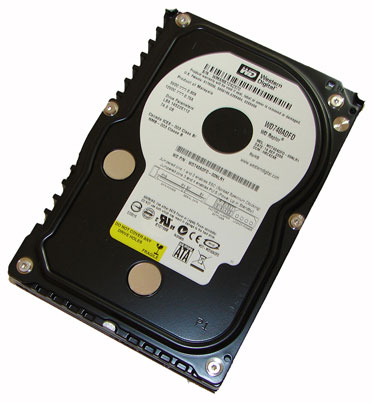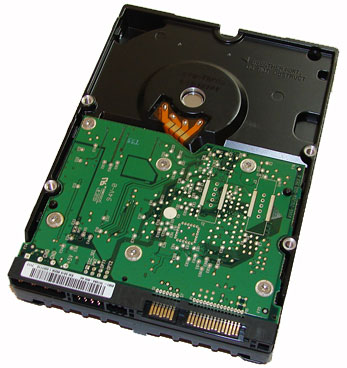Western Digital WD740ADFD: Bottled Lightning
by Gary Key on February 7, 2007 3:30 AM EST- Posted in
- Storage
Feature Set: WD Raptor WD740ADFD

The external design of the Western Digital Raptor series is the same as the majority of their SE16 and RE2 offerings. The familiar all black casing gives the drive a Darth Vader presence in the system as does its performance. The drive is based on the industry standard 3.5" form factor platform with pertinent part number and warranty information embossed on a white sticker on the top of the casing.

The current Raptor family ships with the SATA data and power connectors along with a 4-pin Molex power connector designed for use with older ATX power supplies. To the left of the SATA data and power connectors is an eight-pin jumper block. This jumper block can be utilized to implement spread spectrum clocking or power up in stand by operation. Our test drive was manufactured in Malaysia.
Hard Disk Test Comparison and Features
The Western Digital WD740ADFD drive we are reviewing today will be compared directly against the WD1500ADFD and WD740GD-00FLC0 drive in our limited benchmark test suite. We have also included the results of drives from our previous articles and will provide additional reviews of drives up to 500GB capacity ranges in the near future. The Western Digital Raptor drives ship with a five year warranty.
Hardware Setup
Our current test bed reflects changes in the marketplace over the past six months. Based upon the continuing proliferation of dual core processors and future roadmaps from AMD and Intel signifying the end of the single core processor on the desktop in the near future, we settled on an AMD Opteron 170. This change will also allow us to expand our real world multitasking benchmarks in the near future while providing a stable platform for the next six months. We are currently conducting preliminary benchmark testing under Vista with both 2GB and 4GB memory configurations. We will switch to Vista once the driver situation matures and our benchmark results are repeatable.

The external design of the Western Digital Raptor series is the same as the majority of their SE16 and RE2 offerings. The familiar all black casing gives the drive a Darth Vader presence in the system as does its performance. The drive is based on the industry standard 3.5" form factor platform with pertinent part number and warranty information embossed on a white sticker on the top of the casing.

The current Raptor family ships with the SATA data and power connectors along with a 4-pin Molex power connector designed for use with older ATX power supplies. To the left of the SATA data and power connectors is an eight-pin jumper block. This jumper block can be utilized to implement spread spectrum clocking or power up in stand by operation. Our test drive was manufactured in Malaysia.
Hard Disk Test Comparison and Features
| Hard Drive Specifications | ||
| WD Raptor 150GB WD1500ADFD |
WD Raptor 74GB WD740ADFD |
|
| Stated Capacity: | 150GB | 74GB |
| OS Capacity: | 139.73 GB | 69.24 GB |
| Interface: | SATA 1.5Gb/s | SATA 1.5Gb/s |
| Rotational Speed: | 10,000 RPM | 10,000 RPM |
| Cache Size: | 16 MB | 16 MB |
| Average Latency: | 2.99 ms (nominal) | 2.99 ms (nominal) |
| Read Seek Time: | 4.6 ms | 4.6 ms |
| Number of Heads: | 4 | 2 |
| Number of Platters: | 2 | 1 |
| Power Draw Idle / Load: |
9.19W / 10.02W | 9.19W / 10.02W |
| Command Queuing: | Native Command Queuing | Native Command Queuing |
| Warranty: | 5 Year - Retail or OEM | 5 Year - Retail or OEM |
The Western Digital WD740ADFD drive we are reviewing today will be compared directly against the WD1500ADFD and WD740GD-00FLC0 drive in our limited benchmark test suite. We have also included the results of drives from our previous articles and will provide additional reviews of drives up to 500GB capacity ranges in the near future. The Western Digital Raptor drives ship with a five year warranty.
Hardware Setup
| Storage Test Bed Playback of iPeak Trace Files and Test Application Results |
|
| Processor: | AMD Opteron 170 (2.0GHz 2x1MB) |
| RAM: | 2 x 1GB Corsair 3500LL PRO Settings - DDR400 at (2.5-3-3-7 1T) |
| OS Hard Drive: | 1 x Maxtor MaXLine III 7L300S0 300GB 7200 RPM SATA 16MB |
| System Platform Drivers: | NVIDIA Platform Driver - 6.85 |
| Video Card: | 1 x Asus 7600GS (PCI Express) |
| Video Drivers: | NVIDIA nForce 84.21 WHQL |
| Optical Drive: | BenQ DW1640 |
| Cooling: | Zalman CNPS9500 |
| Power Supply: | OCZ GameXStream 700W |
| Case: | Gigabyte 3D Aurora |
| Operating System: | Windows XP Professional SP2 |
| Motherboard: | MSI K8N Diamond Plus |
Our current test bed reflects changes in the marketplace over the past six months. Based upon the continuing proliferation of dual core processors and future roadmaps from AMD and Intel signifying the end of the single core processor on the desktop in the near future, we settled on an AMD Opteron 170. This change will also allow us to expand our real world multitasking benchmarks in the near future while providing a stable platform for the next six months. We are currently conducting preliminary benchmark testing under Vista with both 2GB and 4GB memory configurations. We will switch to Vista once the driver situation matures and our benchmark results are repeatable.










26 Comments
View All Comments
AnnonymousCoward - Tuesday, February 13, 2007 - link
Good review. I don't think I'll ever buy one of these. For as expensive as they are, the storage size is small and the performance diff is minuscule. Sims2 loading: 30s vs 31s! MP4 conversion: 3:04 vs 3:14! Amazing!Then the thermals and acoustics are really bad.
Lakeshow - Friday, February 9, 2007 - link
I think 74GB is plenty for an OS drive (hell even 36GB should suffice). Sure a 500 gig is cheaper, but I would never use that as my OS drive: simply too much stuff to back up when doing a reformat. Yeah I can do partitions, but then file transfer between partitions is much slower than between two drives, which is why I have my 74GB Raptor as OS drive, 500 giger as D:/storage drive, and then a 36GB Raptor as E: drive for torrent downloads.JonathanYoung - Thursday, February 8, 2007 - link
I think the graphs look great, but in the ones with minutes and seconds, I would suggest using a colon (e.g. 3:05) to denote minutes:seconds instead of a decimal, which makes me think 3.05 minutes (3 minutes 3 seconds). Thanks.Gary Key - Thursday, February 8, 2007 - link
We have an updated graphing engine coming on-line in the next few weeks that hopefully will fix that issue. It bugs me to no end to use the decimal point in that way. ;)TheBeagle - Wednesday, February 7, 2007 - link
Gary, as usual, you did a helluva job on a first-class review on these new generation Raptor drives. However, you especially captured my attention when you wrote "Although TLER is disabled by default, a utility is available from Western Digital to enable TLER." The existence of such a "utility" was a revelation to me. I have a couple of these same 74 GB and 150GB drives, each running in pairs in a RAID 1 environment, and I didn't have any knowledge of such an enabling/disabling "utility." Can you share the source for such a little delight and how we mere mortals get our hands in such a thing? Thanks again for a stellar report, and now we can just hope that WD adopts perpendicular recording (ala 7200.10) and SATA II specs for a world-beater drive. TheBeagleTheBeagle - Saturday, February 17, 2007 - link
I got WD to send me a copy of the TLER "utility." To my surprise, when you run it on new generation Raptor or "YS" series drives, it shows you some very interesting information. First of all there are two (2) separate TLER setting for these drives, namely a read setting and a write setting. On Raptor drives, BOTH ARE DISABLED from the factory! That's right, even though WD advertises this feature as being built into the Raptor drives, it's NOT OPERATIONAL unless you get your hands on the "secret" utility and activate it. On the YS drives, ONLY THE READ feature is activated, and the write feature is disabled. BTW, although WD says that the TLER feature on YS series drives cannot be disabled, the utility has a command that will do just that, disable both the read and write (if you have activated it) feature on those drives. I think WD has some serious explaining to do about all of this, since they (WD) have been creating a false impression to the buying public about these TLER features in these drives!Makaveli - Wednesday, February 7, 2007 - link
he is right it all comes down to your usages pattern, in general home users don't need Raid O. However, if u happen to say be running a webserver from home, or doing alot of Disk intensive stuff its a good investment, but the original Comment still stands.I would never go raid 0 in a gaming rig, a 75/150 Raptor + Storage drive is a far more optimal solution.
Makaveli - Wednesday, February 7, 2007 - link
hey is right it all comes down to your usages pattern, in general home users don't need Raid O. However, if u happen to say be running a webserver from home, or doing alot of Disk intensive stuff its a good investment, but the original Comment still stands.I would never go raid 0 in a gaming rig, a 75/150 Raptor + Storage drive is a far more optimal solution.
Brassbullet - Wednesday, February 7, 2007 - link
So does the fact that I have a WD740ADFD-00NLR as my Windows XP boot drive and a Seagate 7200.10 750 GB as my "My Documents" location mean I'm living the I/O dream? I've had this setup for months and didn't really think much of it, man was this article a PC ego booster!!littlebitstrouds - Wednesday, February 7, 2007 - link
This makes me feel good about the $109 I just paid for my new 150gig at BB because I Vista too.